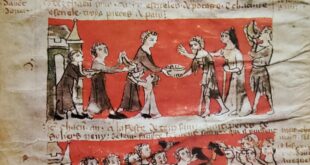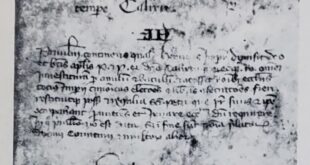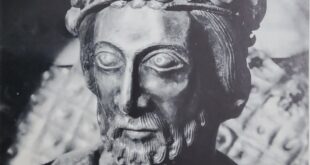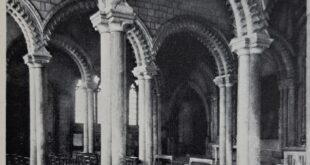Lechfeld, the battleground outside Augsburg on St. Lawrence’s day, 10 August 955 A. D., was highly significant for the whole of Europe. On a battlefield littered with corpses and discarded weapons, the victorious Otto I, had his cheering troops proclaim him Emperor. Germany had been close to civil war and rebellious nobles had allied themselves with the barbarian Magyars, who were intent on destroying what passed for civilzation in tenth-century Germany. It was Otto’s achievement to unite the Germans against both the rebels and the invading Magyars. His new “Roman” Empire differed from the old in its strongly Christian character. Otto was the protector of the Church and constantly encouraged missionary work among the Slavs. His territorial ambitions also lay in the East, but in these he was largely frustrated. Nevertheless, Otto’s victory at the Lechfeld in 955, ensured that much of Central Europe would be safeguarded for Latin Christianity. Even the defeated Magyars who settled in Hungary, became under their great king St. Stephen, a Christian nation.
The battle fought on the Lechfeld outside Augsburg on St. Lawrence’s day, August 10, A.D. 955, was highly significant for the whole of Europe. The victory of King Otto I, over the Magyars, was directly connected with the foundation of his empire and with the constitution of the German imperial Church as a leading political power — which was to survive till its destruction at Napoleon’s hands. The other consequences of Otto’s victory were the re-alignment of the eastern frontier of Bavaria with Austria; the foundation of the Hungarian kingdom with the coronation of Stephen as king; and the formation of Germany’s eastern policy for the next 1000 years.

On August 8, 955, Udalrich or Ulrich, Bishop of Augsburg, stood at the eastern gate of the town — clad only in his stole and without shield, helmet, coat of mail or sword, while the attack on his beleaguered town was at is fiercest and exhorted his people to stand firm. When the attack had been fended off, Udalrich spent the night in prayer. While the nuns walked in procession through the city streets praying and chanting, he lay prostrate in devotion on the cathedral floor, beseeching the Virgin Mary to protect his people and liberate the city. On the following morning, he celebrated communion with his people; the Magyars withdrew from the city as Berthold, the son of Arnul, the Count Palatine, brought them the news of Otto I’s approach.
These strange and deadly enemies, the Magyars, had already made a deep impression on the peoples settled in the German territories by the time they confronted Otto I’s army in 955. Contemporary chroniclers testify to the shock the inhabitants experienced on seeing them; they called the Magyars monsters, fiendish deformities of the human race. According to Widukind of Corvey, Otto I called them “the enemies of God and man” and “the enemies of Christ” before the battle. This gives some indication of the degree of terror aroused by the Magyars, with their Mongolian features, when they swept into western Europe on their raiding expeditions in the fifty years prior to the Battle of Lechfeld.

Who were the Hungarians or Magyars? They had been settled for centuries in the south Russian grasslands between the Don, Donets and Dnieper rivers, until they were driven out in 889 A. D., by the Petchenegs from the region of Atelkuz. They invaded Bulgaria in 894 at the instigation of Byzantium, were repulsed by Simon and crossed the Veretz Pass to settle on the plains on the other side. Under Arpad’s leadership, seven Magyar tribes and an eighth tribe of Khazars known as Kabars, settled on the banks of the River Tiza and the middle reaches of the Danube. The Hungarian plains served as a gathering ground for these nomads, from which they set out on their raids. After the death of Arnulf of Carinthia in 899, they penetrated into Frankish territory across the Danube and destroyed the empire of Great Moravia. Between 896 and 955 they mounted campaigns into central and western Europe. They made thirty-two raids into east Frankish territory; Bavaria was attacked in 907, Franconia in 918, Lotharingia in 920 and Saxony in 924. In 899, 921 and 947, they penetrated into Italy, burning Pavia and reaching as far as Spoleto. They plundered Burgundy, West Franconia and Swabia in 937 and 951, reaching Spain in 943.
The battle of Lechfeld threw the Magyars back towards Hungary, where they finally became settlers. The young Vajk, son of Arpad’s great-grandson Geza, married Gisela of Bavaria in 995 and was baptized with the name of Stephen, patron saint of Passau. His kingdom survived until Horthy, the imperial regent, gambled it away in World War II.
The Magyars, in fact, had had close acquaintance with Christendom since the sixth century, through their Alanic and Armenian neighbours, their contacts with Byzantium and some of their countrymen who were Roman mercenaries. Infact, in the background to the Battle of Lechfeld was the struggle between Byzantium and Rome for the religious and political hegemony over central and eastern Europe, the same region that today is the battleground of the conflict between the western world and Russia. In the early part of the tenth century, the Bulgarians went to Rome for help in their fight against Byzantine imperialist designs, while the Moravians went for help to Byzantium out of fear of the Bavarian Latin Church and Carolingian imperialism.

The Magyars defeated
It was a Bavarian nobleman, Berthold, who reported Otto’s approach to the Hungarian forces outside Augsburg. The ties between the Bavarians and the Magyars formed the direct prelude to the Battle of Lechfeld, which occurred in the middle of civil war in the German lands, and was its peak and its turning point. In the years before 955, Otto was involved in quarrels with his brothers and then with his sons. In the year 954 the dukes who were in revolt against Otto, and the nobility of Swabia, Bavaria and Lotharingia, were in communication with the Magyars through the intermediary of the Count Palatine, Arnulf. Otto’s traitorous son Ludolf provided Horka Bulcsu, the leader of the Magyars, with guides into Franconia and opened the way for him into the heart of his father’s territory. In Bavaria, Duke Henry and Ludolf, brother and son of Otto, were fighting each other for power. Widukind wrote that ‘‘even the bishops showed themselves not a little irresolute, as they sent envoys to both parties.”
Yet, King Otto I’s greatest victory was won before the battle: in the reaction against the Magyar forces that swept across large areas of Germany in 954, he was able to bring the civil war to an end and unite the Franks, Swabians, Bavarians and Bohemians under his command. The Magyars were surprised to find a powerful coalition ready to meet them since, till then, they had been able to exploit the civil strife dividing Germany. The Saxons took no part in the battle, for they were fighting the Slavs from the Elbe; neither did the Lotharingians, nor Henry of Bavaria, who was still suffering from a wound received in an earlier struggle against his brother, Otto; nor did Otto’s son Ludolf, who had been rendered powerless.

Otto’s victory at Lechfeld thus secured his kingdom and according to Widukind’s account, he made his troops proclaim him Imperator, Emperor, on the battlefield itself. In those days, victory in battle was seen as God’s verdict and so Otto’s claim was legitimized. His coronation on 2 February 962, in Rome marks the foundation of Germany: a precarious consolidation of the Germanic races, who had fought each other for their independence, ever since the collapse of the Carolingian Empire. This was the origin of the “Holy Roman Empire of the German Nation” which survived until 1806.
It is true that the adjunct “Roman” originated with Otto II; “Holy” was added in the twelfth century by Frederick Barbarossa and “of the German Nation”, did not come until modern times. Otto I and his successors did not lay claim to Charlemagne’s position. As rulers over Germany and the greater part of Italy (and from 1033 over Burgundy too), these German emperors occupied a special position as protectors of the Church and the papacy. The Emperor had a degree of honorary precedence over other western kings (even this was frequently challenged) but no overlordship or power to command.
Once peace was secured in central Germany by the victory of 955, Otto was able to pursue his territorial gains in the south in Italy and in the northeast. Italy was still in the power sphere of his Byzantine opponent, who had been the unseen ally of the Magyar Horka Bulcsu on the Lechfeld. There was still a chance that the Byzantine Church could gain ground in Hungary, Bohemia, Moravia and Poland; thus indirectly gaining political support for the Eastern Emperor.
Early in 955, Otto had driven the Slavs back to the Oder with his victory at Recknitz in Mecklenburg, and before the Lechfeld battle began he had sworn to found at Merseburg a missionary bishopric dedicated to St. Lawrence if he were the victor. It seems highly probable that Otto considered it his life’s vocation to incorporate the northern and eastern Slavs into his empire. The victory at Lechfeld, which ensured the safety of the southeast, created the necessary military conditions and Rome, was to provide the spiritual impetus. The emperorship would confer a mandate as guardian of the Church, protector of Christendom and the papacy would sanction this role.

The most important experiences of Otto’s youth had had to do with the Slavs: he had already taken part in the Slav wars of 928-29, he spoke Slavonic and a Slav princess bore him his son William, later Archbishop of Mainz. Conversion by the sword, the deus teutonicus or “German god”, proved its worth by success in battle. The war against the Slavs was pursued with utter ruthlessness by the margraves Hermann and Gero — and by Otto himself, from 938 to 950. Widukind testifies to the Saxons’ admiration for the enemy’s bravery (many of the Saxon nobility were confederates of heathen Slav princes, or even related to them by marriage). The Slavs suffered terrible losses and those who survived defeat in battle, were often hanged.
With Otto I, began the German expansion towards the East, which penetrated as far as Riga and Reval in the twelfth and thirteenth centuries. In the tenth century, this expansion encountered formidable opposition. The Saxon nobility was opposed to German colonization east of the Elbe, because it could not raise the high levies from the Christian German peasants, as they could from the heathen Slavs. (Later on in the Middle Ages the Teutonic Order in Prussia reacted in a similar way). In any case, Germany lacked the population and the economic power for such an undertaking. It was not until more than three hundred years later, that settlers from Germany and the West, penetrated into the regions that German swords had fought over in vain for so long.
Otto I himself saw his political expansion into Eastern Europe as a missionary obligation to propagate the faith of the Latin Church. In 955, probably immediately after the Battle of Lechfeld, Abbot Hadamar of Fulda was sent by Otto to lay his plan for Magdeburg before Pope Agapetus II. Agapetus entrusted the creation of new bishoprics to the king’s judgment. Magdeburg was to become a “German Rome.” At the Synod of Ravenna the new metropolitan see was allotted the suffragan bishoprics of Havelberg and Brandenburg, the new bishoprics of Merseburg, Zeitz, Meissen and the newly founded Polish bishopric of Posnania. Otto even thought of adding Prague. Magdeburg was to rank first among all the churches to the east of the Rhine and her establishment, was to consist of twelve cardinal priests, twelve cardinal deacons and twenty-four cardinal subdeacons, on the pattern of Rome.

This was a great plan and if it had been realized, a huge area of Eastern Europe would have come under German domination. It could never become a reality: the German church had too little manpower or spiritual strength to carry the eastern mission through. In 959, Otto had the greatest difficulty even in finding a bishop and a priest, for his proposed mission to Russia.
The strongest resistance to Otto’s over-ambitious mission to the East came from Mainz and Rome. William of Mainz, the first bishop of Germany and Otto’s son by a Slav wife, entered his protest in a letter sent directly to the Pope. According to William, his father’s explanation that he was extending the boundaries of Christendom by converting the Slavs to Christianity, was simply a cover for his real motive: their political subjugation. The son’s attack on the father must have startled the empire — but William maintained this allegation to his death. Then, in 968, Pope John XIII, set the boundary of the archbishopric of Magdeburg at the River Oder. In this, the papacy sought to appear as protector and ally of the nations, whose previous independence was now threatened by the might of Germany. The Pope, like the Holy Roman Emperor, certainly wanted a Latin Western Europe to oppose the heathen and the Greek Byzantine East; but he was not eager to see it take the form of an eastern German empire.

So the greatest of Otto’s plans for the East failed. It was not until several hundred years later that Magdeburg, exerted any influence in the eastern territories and then to, through its municipal laws and its citizen’s rights. The great Slav uprising of 983, repulsed both Christendom and the German rule east of the Elbe. Contemporary witnesses such as Dietmar of Merseburg and Adam of Bremen, thought the aggressive behaviour of the German princes was the immediate provocation. Dietmar complained further, that even Christians were rejoicing over the renewed power of paganism among the Slavs.
At that point however, Otto the Great’s grandson, the young Otto III, had the wisdom to rescue Otto’s work and preserve his achievement from complete destruction. His conception of the new Europe gave the victory at Lechfeld and the German mission to the East, a more lasting significance.
Otto III had the courage to reject the conception of the empire as a military alliance of a dozen German nobles and more than a dozen German prelates, seeking to extend their rule eastwards. He tried to give the empire a reality as a federation of Latin Christian peoples. Therefore, he named the Polish Duke Boleslaw “brother and colleague of the empire” (frater et cooperator Imperii). In the face of the strongest resistance both within Germany and from the papacy, Otto III succeeded – with the aid of his Slav friends -in converting Poland and Hungary to Christianity and thus, won them for the West. In both countries, he founded an independent church. Voytech-Adalbert, Otto III’s great friend and the first Czech Bishop of Prague, became the great Western apostle to the Slavs, with support from both the Emperor and Pope. Adalbert founded the Benedictine monastery of Brewnow near Prague and settled it, with Roman Benedictines as a starting point, for the conversion of Poland and Hungary.

Adalbert’s pupil, Astrik-Anastasius, founded the great Hungarian abbeys of Martinsburg and Pecsvarad; Adalbert baptized King Stephen (who was later canonized) and Astrik became the first leader of the Hungarian Church. Adalbert died a martyr’s death at the hands of the Prussians in 997 and his funeral at Gnesen, was a moving demonstration of faith. He was buried by Duke Boleslaw in the presence of the Emperor and his martyr’s grave, became a rallying point for the foundation of the Polish Church. Gnesen was created an archbishopric in his honour. Otto III’s friend, Bruno of Querfurt, set out from Hungary and traveled as a missionary into the Russian steppes as far as the Volga, coming into friendly contact, with the new Christian state of St. Vladimir in Kiev.
Europe saved for the Latin Church
As for Hungary, the foundation of the archbishopric of Gnesen as a see, independent of the German Church, gave King Stephen the legitimate hope that conversion to Christianity, need not mean submission to Germany. Shortly after the creation of the see of Gnesen, Stephen married Gisela, sister of the Duke of Bavaria and they, carried through the conversion of Hungary to Christianity together.

Otto III wanted to complete the work begun at the Battle of Lechfeld by his grandfather Otto I, using new, more modern techniques. To mark the new European status of his Polish “brother and colleague” Boleslaw, Otto gave him a golden circlet and a duplicate of the holy lance (said to have pierced Christ’s side on the Cross), which Otto I had borne in the Battle of Lechfeld. Otto III even traveled to Aix — as his grandfather, Otto the Great, had done before him — and descended into the tomb of Charlemagne, opened his grave, took the golden cross from his neck and some of his clothing, drew a tooth from his mouth and clipped his fingernails. In this way he hoped to transfer to himself some of Charlemagne’s power and charisma. When he died prematurely in 1002, his successor Henry II, buried Otto III’s remains in Augsburg, in Udalrich’s tomb chapel. The holy power of the bishop, who had seen the Battle of Lechfeld, together with that of the dead Emperor, were to help Henry bear his heavy burden of office.
These then, were the consequences of the Battle of Lechfeld. If the Magyars had won, the Byzantine East would have penetrated with them, deep into the heart of central Europe. Otto I’s victory, made it possible to gain Hungary, Poland and to safeguard Bohemia; and Moravia for the West and for its Latin Church. Byzantium gained Russia and came to a halt at the Balkans — where the Roman papacy and the central European powers came into conflict with Russia and the Orthodox Church in 1914.

























